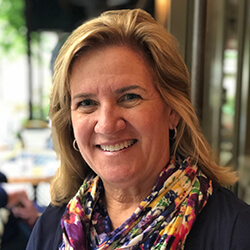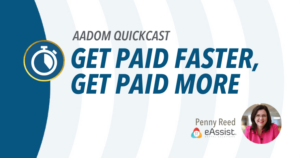You Know The “Why,” Here’s The “How” (SOPs)
Part 2 of 3

This is the second part of a three-part article aimed at discussing the importance of dental standard operating procedures (SOPs) for the administrative team. If you have not read part one yet, you can read it here. In SOPs part one, we considered the four “P’s of why your administrative team needs SOPs. In review, SOPs:
- Identify Parameters
- Measure Performance
- Increase Productivity
- Provide Protection
Now that you know why the admin team needs SOPs, let’s explore the how.
Three Easy Steps for Developing Dental Practice SOPs
1. Brain dump
Create an exhaustive list of all the procedures and processes your practice performs.
Separate by teams: administrative, hygiene, assistant, and dentist. For the purpose of this article, focus on the administrative team. Standard operating procedures for the administrative team consist of any operation or procedure your admin team performs, ranging from checking-in patients, collecting forms, answering phones, and changing the toner in the printer.
Ask yourself and your administrative team,
“What do we do every day, week, month, and year?”
Write down Every. Single. Thing. During this brain dumping activity, gather a notebook, journal, or note app on your cell phone or tablet, and literally “dump” all the tasks and responsibilities in your brain that you and your administrative team perform. Don’t worry about prioritizing, this will come next. Simply list out all the operations and procedures you can think of.
I found one easy way to start this process is to think about every detail it takes to run the front office from the start of the day, such as opening the office, to the end, such as closing the office. List those operations and procedures in chronological order. Include daily, weekly, monthly and annual tasks.
Ask yourself:
“Why is this procedure important to our dental practice?
“Why do we need to do this?
“How does it help the practice, the team members, or the patients?
“Does this task contribute to the growth of the practice or the quality of care we provide?
“Does it help us provide excellent customer service?”
2. Categorize your brain dump in order of frequency and importance into four categories:
- HF/HI = High frequency (every day); high importance (ex: patient safety – COVID screening; Health History Updates)
- LF/HI = Low frequency (weekly or less often); high importance (ex: financial reporting such as End-of-Month and End-of-Year reports; handling a medical emergency in the dental office)
- HF/LI = High Frequency (daily); low importance
- LF/LI = Low frequency (weekly or less often); Low importance (ex: getting the carpet cleaned or having the office painted)
Prioritize and organize the procedures and tasks in order of frequency and importance. The HF/HI items will be those procedures and tasks you will want to tackle first while the LF/LI tasks will be lower on the priority list with LF/HI and HF/LI falling somewhere in the middle.
If there are any procedures that have a significant choke point in your front office operation or any procedures that you or your dentist feel are a priority, you may need to place those higher on your priority list. If there is a task that needs to be completed frequently that everyone needs to know how to do, you may need to create an SOP for this sooner than later. Some tasks may be completed every day with ease and are not currently causing disruption to your team’s productivity. You will still want to create an SOP for these items but can wait until your higher priority SOPs are developed first.
3. For your first attempt at an SOP, create a draft of the easiest, least complex procedure.
- Detailed List – Make a detailed list of all of the steps required to perform the procedure/operation
- Write down every single detail as you perform the procedure yourself or as you observe someone else.
- Collect information from all team members who have input regarding the specific SOP; utilize team members’ experience, knowledge, wisdom, and ideas to improve the processes.
- Research and compile the procedure instructions from the companies and organizations you work with (i.e. software management systems; equipment manuals; third-party dental software programs, etc.).
- Utilize evidence-based research articles as much as possible to develop your SOP.
- Note: Evidenced-based research is based on research, not opinions. Seek several sources of published dental articles in dental journals or online that include scholarly articles and/or reviews of current research. Include information from the manufacturer’s instructions etc.
- Just because we have always done something a certain way, that does not justify why we should continue to do it that way. This reminds me of the story of the woman who cut the ends of the ham before placing the ham in the oven. When asked by her husband why she did this, she said, “That’s the way my Grandma did it.” Her grandma had already passed on so she asked her grandfather, and he responded, “So the ham could fit in the baking pan.” By utilizing evidence-based research, we define the most current practices and avoid doing something “because that’s the way we’ve always done it.”
- Seek Input – Provide each admin team member with a copy of the steps for the SOP and ask them for their input. Review the SOP yourself, have a team member review the SOP, and edit and revise any details needed so that anyone who picked up the SOP could complete the task using your standardized operating procedure for your practice.
- Independent Performance – If possible, have a team member who is not familiar with the procedure complete the SOP to determine if there are any areas that need to be revised.
- Edit the SOP as necessary based on the above.
- Finalize the SOP and store it in an SOP manual, print or digital. Personally, I would like to transition to digital.
- Train all team members who will be performing the SOP.
- Review – Annually review and revise or more often if procedures change.
We know the why and the how of SOPS for the Administrative Team in the Dental Practice. Use these three easy steps to begin creating an SOP manual for your practice. First, do a Brain Dump. Next, prioritize your brain dump into four categories (HF/HI, LF/HI, HF/LI, and LF/LI). Finally, put your draft on paper.
If you would like a sample administrative SOP, please send me an email request.
About the Author

Debbie Jones, RN MN, FAADOM is the Practice Administrator for her husband Mike Jones’ General Dental Practice in Newport Beach, CA. She joined him because they thought it would be a good idea for her to help cover for the Admin Team. Little did she know that her career would transition to full-time dental administration.
Debbie is a lifetime AADOM member and received her AADOM Fellowship, (FAADOM) in 2021. She loves learning and has attended every conference since 2018 when she joined AADOM. Debbie is on track to receive her AADOM Mastership, MAADOM, in 2022.
Debbie Jones RN MN
Practice Administrator
Michael Jones Dental Corporation
1401 Avocado Avenue Suite 603
Newport Beach, CA 92660
DebbieJones@MikeJonesDDS.com







